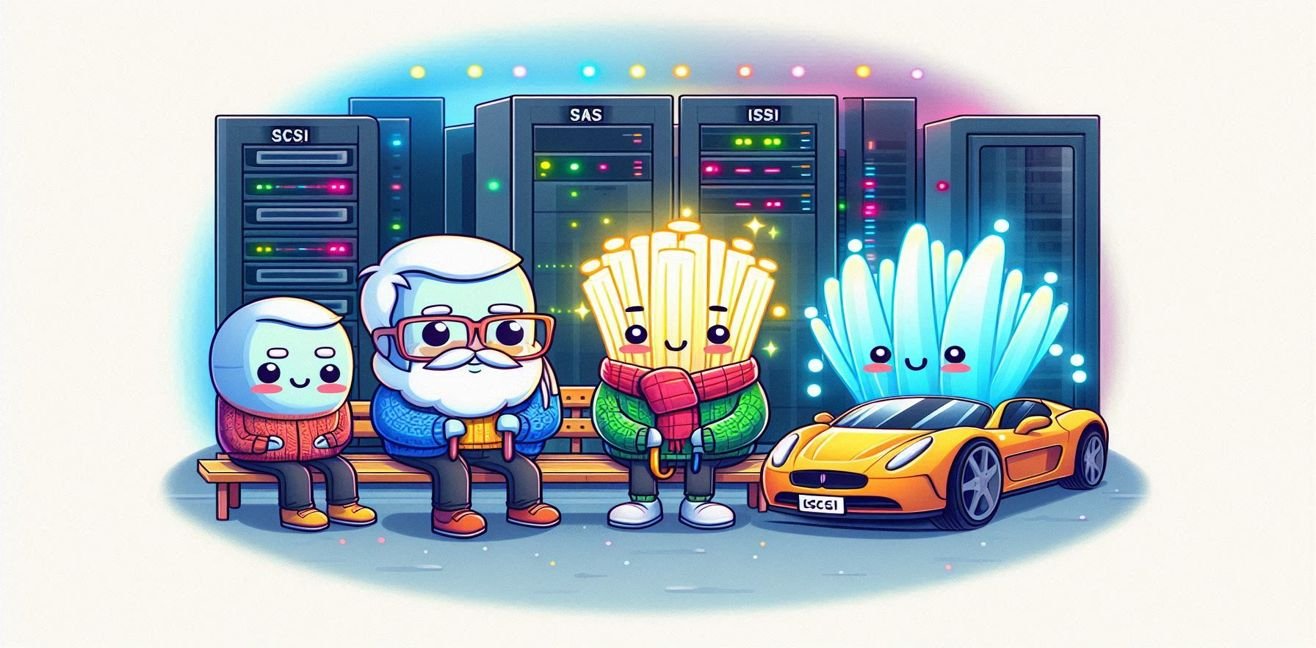Storage systems are the silent heroes of the computer world. While the CPU takes the spotlight on stage, and RAM keeps shouting “my speed is enough!”, storage systems quietly do their job backstage: storing data, protecting it, and keeping it accessible. But accessing data is not as simple as “go grab it from the cupboard.” This is where different interface technologies step in: SCSI, SAS, FC, and iSCSI.
In this article, we’ll explore the origins, working principles, speeds, use cases, and pros and cons of these technologies. Of course, with plenty of metaphors and little jokes, as always. 😏
1️⃣ SCSI (Small Computer System Interface) – The First Love of History
📜 History: Emerged in the 1980s.
🔗 Concept: Parallel communication (multiple data lines at once).
⚡ Speed: Started at 5 MB/s, later versions up to 320 MB/s.
📍 Use Cases: Servers, workstations, printers, disks.
👉 SCSI was like the jack-of-all-trades lover of computers. You could connect multiple devices (disk, printer, scanner) to a single cable line. But because of parallel communication, “traffic jams” were inevitable. On top of that, terminators and device ID settings were a headache.
Advantages:
- Versatility (supporting everything from disks to printers).
- High performance for its time.
Disadvantages:
- Complicated cabling.
- Limited scalability due to parallel communication.
⚠️ Note: SCSI has stepped off the stage, but its descendants (SAS and iSCSI) are still alive.
2️⃣ SAS (Serial Attached SCSI) – The Modern and Strong Kid
📜 History: Appeared around 2004.
🔗 Concept: Serial communication (fast and orderly data flow through a single line).
⚡ Speed: 3 Gbps → 6 Gbps → 12 Gbps (24 Gbps on the way).
📍 Use Cases: Server disks, enterprise storage, RAID arrays.
👉 SAS abandoned SCSI’s parallel chaos and moved into the serial world. Thinner cables, less mess, more speed. It also offers backward compatibility with SATA drives. Imagine driving a sports car that can also pick up your minibus friend along the way. 😅
Advantages:
- High speed (12 Gbps).
- SATA compatibility.
- Reliability for large-scale systems.
Disadvantages:
- More expensive than SATA.
- Mostly used in server rooms, not really for home users.
3️⃣ FC (Fibre Channel) – The Luxury Sports Car
📜 History: On the enterprise stage since the 1990s.
🔗 Concept: Fiber optic (sometimes copper), a low-latency dedicated protocol.
⚡ Speed: 8 Gbps → 16 Gbps → 32 Gbps → 64 Gbps (128 Gbps in testing).
📍 Use Cases: SAN (Storage Area Network), large data centers, banks.
👉 Fibre Channel is the Ferrari of the storage world. 🚗
- Not just speed, but also low latency and high reliability.
- But it requires specialized switches and HBAs (Host Bus Adapters). Translation: this lover comes with a high price tag.
Advantages:
- Extremely high speed and reliability.
- The de facto standard in SAN environments.
- Highly scalable.
Disadvantages:
- Expensive hardware.
- Complex installation.
- Not as flexible as Ethernet.
4️⃣ iSCSI (Internet Small Computer System Interface) – The Budget-Friendly Partner
📜 History: Became popular in the early 2000s.
🔗 Concept: Transports SCSI commands over TCP/IP.
⚡ Speed: Depends on Ethernet: 1 Gbps, 10 Gbps, 25 Gbps, 100 Gbps.
📍 Use Cases: Medium-sized businesses, cloud infrastructure, low-budget SAN systems.
👉 iSCSI was essentially the idea of “bringing SCSI to the Internet.” No need for special cables; you can build a storage network over the existing Ethernet infrastructure. That makes it cheaper.
Advantages:
- Affordable and flexible thanks to Ethernet.
- Easy remote access.
- Can run on any TCP/IP network.
Disadvantages:
- Can suffer latency because it shares traffic with Ethernet.
- Not as fast as FC.
- Without QoS, “the intern watching YouTube” can kill SAN performance. 😅
📊 Comparison Table
| Feature | SCSI (Parallel) | SAS (Serial) | FC (Fibre Channel) | iSCSI (IP-based) |
|---|---|---|---|---|
| Release Year | 1980s | 2004 | 1990s | 2000s |
| Speed | 320 MB/s | 12 Gbps | 64 Gbps (128 Gbps test) | 100 Gbps (Ethernet-based) |
| Cabling | Thick, parallel | Thin, serial | Fiber / special copper | Ethernet |
| Cost | Medium (now obsolete) | Medium-High | Very High | Low-Medium |
| Use Cases | Historical | Servers, RAID | SAN, large data centers | Medium-sized companies, cloud |
🎯 Conclusion: “The Love Map of Storage”
- SCSI → The first love, nostalgic. Retired but remembered.
- SAS → Strong, reliable, modern. A server favorite.
- FC → Luxurious, expensive, but a performance beast. The darling of big enterprises.
- iSCSI → Affordable, flexible, the partner that “works anywhere” thanks to Ethernet.
💡 In short, my love, which interface you choose depends entirely on your needs:
- SATA is enough for home,
- iSCSI for medium businesses,
- SAS for server rooms,
- FC for banks and high-security environments.
And don’t forget: storage technologies, just like love, make life beautiful when the connection is right. 💾❤️




